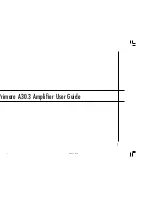
GR-1 Supplemental Notes
© 1995 Roland Corporation U.S.
GR-1 MIDI Sequencing
Page 7 of 7
A: Controller 7 is used for master volume. Controller 11 is an expression control within the master volume. For
example if we set controller 7 to 50, controller 11 would be a volume control with a maximum volume of 50.
Q: Can I dump the sequence I made on the GR-1's internal sequencer to an external sequencer to continue
editing?
A: A sequence made using the GR-1's internal sequencer can only be transferred to external sequencer for
storage purposes. The only way the GR-1's sequencer will send out its contents is via a bulk dump. This
information is sent using a different type of transfer that a sequencer is not able to interpret and change to
note information.
Q: How come my tape sync device does not work properly when the GR-1's MIDI Out is connected to my MIDI
system?
A: The GR-1 outputs active sensing messages at all times. Although part of the original MIDI specification, active
sensing messages can cause problems with tape sync devices and can cause timing mistakes on the tape
sync device. These messages can not be turned off, therefore, disconnect the MIDI out of the GR-1 while
using tape sync devices. You can also filter active sensing with many patch bays and MIDI interfaces.
Q: How come I’m hearing all the music I have recorded playing the tone I’ve selected?
A: While you are in the tone select screen, the GR-1 changes to OMNI ON. In this mode, no matter what MIDI
channel you send to the GR-1, it will play the currently selected tone. Exit this screen to alleviate this problem.
Q: How come I am not able to hear the Patch that I recorded play back when using an external sequencer on
MIDI channel 1?
A: When the GR-1 is in MONO mode, the BASIC channel and the next 5 channels are used for the current Patch
in memory. If you have the BASIC channel set to 1 then you are using channels 1-6 for the Patch. The Parts
that are set up in the sequencer section of the GR-1 will override the Patch of the GR-1. Change the BASIC
channel of the GR-1 to 11 to alleviate this problem.
Q: How do I sync the internal sequencer of the GR-1 to an external sequencer?
A: It is not possible to have the GR-1's internal sequencer follow an external MIDI device via MIDI clock. The
GR-1 does transmit MIDI clock messages when its internal sequencer is started. If you wish to sync the GR-1
internal sequencer and another device you must connect the MIDI out of the GR-1 to the MIDI IN of an
external sequencer. Then you must set the external sequencer to follow MIDI clock. However, the GR-1 does
not respond to MIDI clock messages unless it is in DOWNLOAD mode. DOWNLOAD mode is used for the
purpose of transferring a song from an external sequencer to the internal sequencer of the GR-1.
Q: Can I put the GK-2A pickup in a different position on my guitar?
A: While the control section of the pickup can be moved to various positions, it is important that the pickup
mechanism itself be installed in a manner as directed by the GK-2A owner's manual. Please use the picture in
the GK-2A's owner's manual as your guide to installation.
Q: Why am I not able to select expansion board Patches from the PN-GR1-01 while using my GR-1 with MIDI?
A: The is caused when the GR-1's MIDI IN and OUT are connected to an external MIDI device and a MIDI loop is
created. The Patches on the PN-GR1-01 have been made with program changes 1-64. When selecting
Patches from the PN-GR1-01 card with your GR-1 you will send out these messages. These program
changes bring up the first 64 Patches of the GR-1 instead of the card Patches. For instance, after you select a
Patch such as 311, the GR-1 will transmit program change 1, receive it and then change to 111. There are a
few ways to fix this problem. Turning the Basic Channel to OFF will stop the GR-1 from transmitting or
receiving program changes. You can also filter program changes on your external MIDI device so they do not
get back into the GR-1.
Summary of Contents for GP-100
Page 1: ...BOOK ...
Page 2: ......
















































